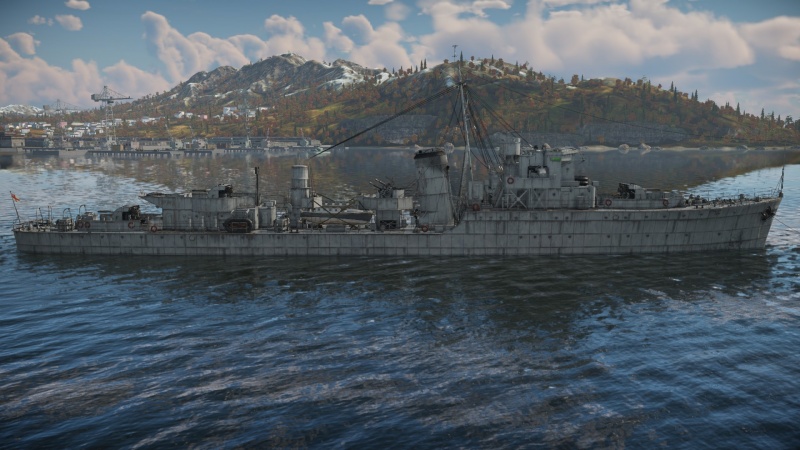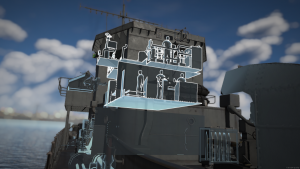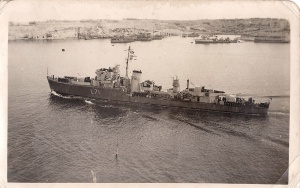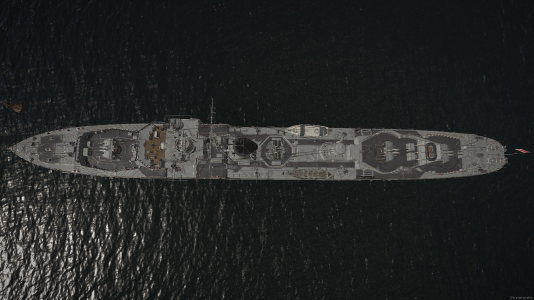Difference between revisions of "HMS Calpe"
(Edits) |
(Edits) |
||
| Line 50: | Line 50: | ||
Even with the below-average top speed, the ship will eventually reach distant grid squares in the naval maps, however, HMS Calpe should not be played this way; unless as part of a larger fleet - Calpe won't usually be the first in the battle group in Realistic battles. | Even with the below-average top speed, the ship will eventually reach distant grid squares in the naval maps, however, HMS Calpe should not be played this way; unless as part of a larger fleet - Calpe won't usually be the first in the battle group in Realistic battles. | ||
| − | The mobility is similar to the [[ | + | The mobility is similar to the [[HMS Churchill]], another escort destroyer, in which staying near the coastal areas provides better rewards and protection from the marauding combat-worthy fleet destroyers. This slow pace is actually beneficial for her gameplay, as she is now capable of positioning safely behind the combat. Using her small size to lurk in the boats' area is also a valid tactic. |
The worst scenario for the Hunt class is rough open seas, as the short length and narrow hull decreases seakeeping. This coupled with the already reduced speed, just makes Calpe a sitting duck for anyone faster or with bigger guns- Some torpedoes are also twice faster than her, like the lethal Japanese "Long Lance" Torpedo [[Type 93 Model 1, Mod 2 (610 mm)|Type 93 Model 1]]. | The worst scenario for the Hunt class is rough open seas, as the short length and narrow hull decreases seakeeping. This coupled with the already reduced speed, just makes Calpe a sitting duck for anyone faster or with bigger guns- Some torpedoes are also twice faster than her, like the lethal Japanese "Long Lance" Torpedo [[Type 93 Model 1, Mod 2 (610 mm)|Type 93 Model 1]]. | ||
| Line 151: | Line 151: | ||
'''Cons:''' | '''Cons:''' | ||
| − | * Not enough top speed to match analogous destroyers; playstyle is similar to the equally-paced [[ | + | * Not enough top speed to match analogous destroyers; playstyle is similar to the equally-paced [[HMS Churchill]] |
* No torpedo armament; limits the anti-ship capabilities to just the main guns | * No torpedo armament; limits the anti-ship capabilities to just the main guns | ||
* Below average crew size when compared with other nations' destroyers | * Below average crew size when compared with other nations' destroyers | ||
Revision as of 19:16, 22 July 2022
Contents
Description
The Hunt-class, HMS Calpe (L71), 1942 is a rank British destroyer with a battle rating of (AB), (RB), and (SB). It was introduced in Update 1.95 "Northern Wind".
HMS Calpe, pennant number L71, part of the Hunt class, is an Escort destroyer build for the Royal Navy during 1940. She was commissioned at the beginning of the Second World War, on 11 December 1941; to protect the vital supply and trade lines of the British isles.
HMS Calpe is another positive gameplay leap in the British destroyers. Using superior fire rate and a vast amount of firepower to annihilate any aerial or seaborne threat, keeping secure all the friendly ships nearby.
Despite not being the swiftest nor having a large intimidating destroyer shape, her cargo ship appearance allows to confuse anyone who devalues her combat capabilities!
General info
The Hunt class is reasonably slow and won't likely reach most of the distant capture zones alive. Her crew size is another unfavourable factor, since she is not fast enough to avoid the enemy artillery but also not strong enough to resists them.
Players using the Calpe should practice their gunnery skills if they want to master this escort destroyer. As her powerful 4 inch/45 Mark XVI cannons will cause a lot of unstoppable damage if fired accurately.
Survivability and armour
Unlike her extremely fast destroyer adversaries, HMS Calpe relies on quick firepower and covered positioning as the best means of defence.
The compact and unaggressive silhouette scarcely resembles a regular British destroyer of early World War II epoch, such as the G-class or the K-class; this is because the ship was built to accompany and oftentimes disappear amongst the cargo ships.
This concealment plays a relevant role in the survivability of the Calpe. As with the slow top speed and small size, one of the best ways to survive in the Calpe is to hide with the coastal borders area or near land formations; awaiting for any vulnerable patrol boat or aircraft to reach within firing range.
Calpe's moderate crew size won't allow any direct combat with dedicated destroyers, whose crew size numbers are often double. Destroyers such as the German Type 1934A, the Japanese IJN Yugumo and the Italian RN Comandante Margottini, fit very well in this class. Their equally powerful firepower and yet adequate crew size are a challenge for the slow Calpe.
Armour
HMS Calpe's hull is made of 16 mm of steel while the superstructure is protected by 4 mm of steel.
This is just not enough to stop most rounds, as even aircraft's heavy machine guns (12.7+ mm) can strafe the Calpe and cause considerable damages and crew casualties.
The turret's antifragmentation armour protects against any HE shell, but they remain highly vulnerable to SAP rounds. The armour is still useful to conserve the indispensable fire rate of the main turrets until the threats have been eliminated. If the turrets get disabled by SAP shells, Calpe could rely on the 40 mm 2pdr gun to survive until the main turrets are repaired.
Ammo racks
The ammunition is well placed just under the waterline, however, there's a large amount of ready-use ammo racks inside steel containers near all the main turrets, each of them with 40 rounds. It only takes a single direct hit with a powerful shell to cause major damage to the destroyer.
If the players want to decrease the chances of this ammo to detonate, they can simply engage at will using the high rate of fire until all the ready-use ammo rack is spent.
Mobility
Even with the below-average top speed, the ship will eventually reach distant grid squares in the naval maps, however, HMS Calpe should not be played this way; unless as part of a larger fleet - Calpe won't usually be the first in the battle group in Realistic battles.
The mobility is similar to the HMS Churchill, another escort destroyer, in which staying near the coastal areas provides better rewards and protection from the marauding combat-worthy fleet destroyers. This slow pace is actually beneficial for her gameplay, as she is now capable of positioning safely behind the combat. Using her small size to lurk in the boats' area is also a valid tactic.
The worst scenario for the Hunt class is rough open seas, as the short length and narrow hull decreases seakeeping. This coupled with the already reduced speed, just makes Calpe a sitting duck for anyone faster or with bigger guns- Some torpedoes are also twice faster than her, like the lethal Japanese "Long Lance" Torpedo Type 93 Model 1.
To aid the stability problem she has been fitted with rare fin stabilizers under her waterline. Although not popular amongst other British destroyers of the era, they reduce the roll and increase the seaworthiness while on stern sea. This mobility improvement also helps to increase the effectiveness of anti-air fire while underway.
| Mobility Characteristics | |||
|---|---|---|---|
| Game Mode | Upgrade Status | Maximum Speed (km/h) | |
| Forward | Reverse | ||
| AB | |||
| Upgraded | |||
| RB/SB | |||
| Upgraded | |||
In calm waters and fully upgraded, HMS Calpe reaches top speed within just 25 seconds. From full speed, a total halt is achieved in around 30 seconds, with a subsequent total reverse speed in only 13 seconds. This good aspect of the mobility should help the captains when evading incoming torpedo attacks or when steering during manoeuvres in shallow waters.
Her turn range is moderately large for a destroyer meant to fight against submarines, with a full steering circle in approximately 1 minute 25 seconds but sustaining a speed of 35 km/h in full steering.
Modifications and economy
Depending on the patience and perseverance of the player commanding the HMS Calpe, the mobility modifications should be acquired first - after FPS and Tool Set of course. If slow speed is not an issue, several firepower modifications can be acquired, such as the SAP shells and the Primary turrets targeting speed.
Armament
Primary armament
Lack of firepower is not what Calpe is known for, in fact, she is one of the fastest-firing ships at her rank, with an overwhelming initial fire rate of 20 rounds per min!
Calpe is primarily armed with a set of 3 x turrets each holding 2 cannons of the British-made, dual-purpose 4 inch/45 Mark XVI., one located in the bow, and the other 2 located in the aft of the ship.
The guns provide an enhancement in fire rate from early British destroyers, however, the explosive damage per round is yet lower than the G-class (H89)'s 3 kg of TNT (1.55 kg on Calpe). This means the player needs to fire accurately, otherwise, the enemy will remain afloat. One of the recommended ways is to fire using the ranging fire key. This will enable the turrets to fire each gun individually, providing leading and correction for the fast-firing cannons in the other turrets. This not only develops a good naval artillery accuracy but also helps when engaging a ship nearby as evenly dispersing the shells through their entire hull causes irreparable sudden damage to the ship and the crew. - As if the HMS Calpe is engaging the target with a non-stop barrage of shells!
It is not recommended to use this ranging fire tactic at long ranges, as it severely limits the amount of damage due to correction errors and inaccuracies in each firing. Hence, it is more powerful to fire in full volleys at long distance - also the splash is more easily observable in Realistic battles.
| To use ranging fire, proceed to Ship Controls configurations. It is also possible to select if the turrets will fire with all cannons, in Options. |
The guns provide decent ballistics thanks to the shells' 811 m/s muzzle velocity, which is comparable or better than what is presented earlier in the British destroyers. The elevation angles are notoriously reliable, nearly 90°, this is because the guns are dual-purpose, able to engaging both seaborne and airborne targets effectively. The variety of shells is also useful for facing off against most of the targets at her rank. With the turrets and their targeting speed of 17°/s, faster than any earlier British destroyer.
The 4 inch/45 Mark XVI cannons can use 4 types of ammunition:
- 4 inch HE
- 102 mm SAP
- 4 inch HE-TF
- 4 inch HE-VT
The HE is advised as standard ammunition versus most sea targets. SAP is often required to counter the decently armoured American destroyers and Soviet Armoured boats. While HE-VT is the recommended shell against any air target.
Although they have a low explosive mass, HE shells are still powerful enough to trigger a hull break on most small boats, which is helpful when defending coastal areas. The range of the guns is over 12 km, usable for any situation where really good gunnery is needed; like with cargo ships on Encounter mode.
Secondary armament
Amidships, a single quadruple 40 mm 2pdr Quick Firing Mk.VIII automatic cannon is mounted.
Although being more range-limited when compared to the main armament, the 2 pounder cannons provide flexible firepower against any agile fast craft or aircraft reaching within the safe space of the Hunt class. Though, note that when stock, the gun's targeting speed is really poor and might take up to 20 seconds to acquisition a target lead. Although once on the target, the are deadly at close range, as the tight packet cannon offer devastating damage with also acceptable penetration and explosive damage.
The gun's range when controlled by AI gunners is approx. 4.0 km.
Anti-aircraft armament
On both starboard and port, several 20 mm/70 Oerlikon Mk.II and 20 mm/70 Oerlikon Mark 24 are located.
If both the 40 mm turret and the main turrets fail to stop an incoming threat, the 20 mm Oerlikon guns will be there as last resort stopping power. Their AI gunner range is roughly of only 1.5 km but their fire rate and damage remains noteworthy because of the amount of guns present on each side of the ship. They are also useful for really agile small boats trying to sneak behind or from the sides of Calpe.
Bombers like the German He 111 (Family) or nimble fighters like the Japanese naval fighters, A6M2 will have a tough time against them because of how fast and powerful they fire. Notwithstanding, attack planes like the Ju 87 (Family) or the Soviet IL-2 (1942) will be sturdy armoured opponents to the Oerlikons; all unfortunately ending with them too close to HMS Calpe and raining fire upon it - Oftentimes these planes can chew up multiple shoots from the 20 mm at point-blank range and remain airworthy.
Additional armament
While the ships carries a large number of depth charges available, their use is currently limited. As they were historically used by Allied escort destroyers to protect convoys from German submarines; vehicles not present in the game yet.
Usage in battles
Because of the not-record-breaking speeds of the HMS Calpe, she won't usually find combat quickly rather depending on the map. But she can reach those points just in time to guard them, and to provide air protection to any allied ship in her proximity; mainly when the enemy air force is on the way with bombs under their wings; as a solid anti-air emplacement. This tactic serves more in Realistic battles because on Arcade, the enemy planes can easily bomb the Hunt class and she needs to always be on the move - players perhaps should navigate on the allied side of the map.
One of the easiest ways to play the Hunt class is to engage lighter boats or ships. For this, proceed to the coastal areas of the map and if necessary get inside capture zones. Look for a place adequate to avoid any pop-up attacks. As a single bomb of more than 500 kg might be fatal for the Hunt Class destroyer. The same care must be taken for areas where torpedo strikes against the slow Calpe might arrive.
In high-ranked battles versus other more combat capable destroyers, Calpe players must practice how to protect themselves with accurate and first-fired attacks over the enemy; those attacks must be resolute enough to maim the enemy capacities to retaliate. Additional only to a good sense of teamwork to remain near the most influential player's combat fleets, providing anti-air defences while they engage other ships. Captains can let the firepower of the HMS Calpe reach overwhelmingly the enemy destroyers while staying safe from behind. Or go full-in on the coastal approaches, hoping to face-off the entire enemy mosquito fleet.
The Hunt class relishes on close maps, as her really fast firepower can be put to test duelling with anyone close. On the other hand, distance engagements are also beneficial for the integrity of the ship, but they require more skills from; the choice is up to the player.
Pros and cons
Pros:
- 3 turrets with 2 cannons each provide adequate damage and gun ballistics; more effective than single mounted turrets
- 102 mm turrets are capable of hullbreaking any troublesome small boat
- Excellent initial rate of fire of 20 rounds/m; even more effective with the use of ranging fire key
- Dual purpose main cannons give an adequate anti-air defence
- Effective amount of secondary and auxiliary armaments; with numerous depth charges also available
- Modest crew size improvement from the early British destroyers (+19 from HMS Grafton)
- Unique fin-stabilized hull amongst British destroyers
Cons:
- Not enough top speed to match analogous destroyers; playstyle is similar to the equally-paced HMS Churchill
- No torpedo armament; limits the anti-ship capabilities to just the main guns
- Below average crew size when compared with other nations' destroyers
- Main ammunition can be depleted quickly because of the high rate of fire
- No significant armour protection in the hull or near the ammo storage
History
Even before the outbreak of the Second World War, the British Admiralty had noted the importance of persuasive merchant protection, with the concept of Escort Destroyers.
Hence, after some major flaws were corrected in the sloop-based Hunt class design, the Type II HMS Calpe was laid down complete in 1941, following being ordered on the 1939 emergency program; just in time for the commencement of the Second World War. After acceptable trials despite her short and narrow hull with also an insufficient range for open sea work, she sailed to the Royal Navy's base in Scapa Flow, Scotland and remained on standby for any operation limited to the Mediterranean and the North Seas.
On Early 1942, HMS Calpe participated along the Home Fleet in various exercises, convoy patrols on the North West approach and as Escort for Minelaying operations.
Operation Jubilee
From July to august of the same year, she took part in the preparations of the Operation Jubilee, also known as the Dieppe raid. Under the control of Major-General Roberts (OC, 2nd Canadian Infantry Division) and Captain John Hugues-Hallet RN (Naval Commander for the raid), she was used as a command ship for the coordination of the landing operations and RAF's attacks.
She received heavy fire caused by enemy aircraft and artillery batteries from the shore, causing numerous casualties on the ship's crew. Even after these intense German bombardments, the ship performed as a hospital for the raid's wounded, protecting the life of about 250 casualties.
After the inconclusive raid, she escorted the surviving forces and landing crafts back to Portsmouth.
Task Force H
In October, she was placed briefly back on escorting duties and flotillas patrols, until she was appointed for the North African Theatre.
HMS Calpe was sent to Gibraltar and put inside the Task Force H, where she patrolled the western Mediterranean and Atlantic, protecting more convoys and executing anti-submarine warfare. She took part in Operation Torch, Retribution, Husky and Avalanche; principally in support and Escorting role - various times under E-boat attacks and Luftwaffe's strike but surviving intact.
Demand for resolution
One of her most difficult times during service was in December 1943. She was part of an Escorting convoy group comprising HMS Holcombe and HMS Tynedale (Both Hunt-class Destroyers), working along with the US Destroyers, USS Wainwright, USS Benson and USS Niblack.
Over the Bay of Bougie, off the coast of Algeria, the convoy KMS34 was intercepted by the German submarines U-593 and U-223.
Early in the morning of the 12th, the U-593 spotted the convoy and shifted to periscope depth for an attack. It was a hit, regardless of the extended zig-zagging of 120° every 5 minutes, HMS Tynedale received a torpedo impact on the port side abreast the funnels breaking the ship in half. The convoy immediately started "Swamp operations" - a codename for wolfpacks hunting during convoy protection. The U-593 remained under attack range despite the launching of the depth charges, and not much later after the first destroyer sank, they engaged the second Hunt-class, hitting her aft and sinking the HMS Holcombe. HMS Calpe now was left alone on account of the Royal Navy.
The U-593 now took evasive actions and went off the defensive. Around 8:15 PM of that same day, U-593 surfaced to recharge batteries, to her misfortune, she was spotted by a South-African Wellington Bomber and its searchlight. This brief encounter was then reported to HMS Calpe and the US escort destroyers.
On the morning of December 13th, The Asdic operator (Anti-Submarine Detection Investigation Committee, later named Sonar) onboard the Calpe identified a submarine contact forward; the hunt has begun. Along with USS Wainwright, Calpe performed depth charges attacks continuously damaged the submarine. The commander, (Lieutenant) Kapitänleutnant Kelbling Gerd gave the order to dive deeper, but an explosion damaged the submarine and water begun to ship in, making the dive impossible and slowing the submarine. The submarine commander himself recalled how the unusual noises similar to "pebbles hitting a wall", could be heard on both sides of the submarine's hull. This is thought to be the sonar ping effect of both Asdic devices from Calpe and Wainwright sweeps, working on proximity to sink the U-593.
On the vicinity of the coordinates 37° 49' N., 06° 00' E, Calpe and Wainwright performed numerous runs with depth charges patters of 6 or even 10-charges pattern at once. Wainwright's captain, Commander Walter W. Strohbehn, intended to ram the submarine but about 2:47 p.m. the submarine surfaced because of the extensive hull and mechanical damage.
Upon the appearance of the submarine, it was received by fire from both sides, with Wainwright 2,000 yards north-west of her and Calpe 2,000 yards south-west. The U-boat crew started to quickly abandon the ship and the Commanding Officer of Calpe, Lieutenant Commander H. Kirkwood, ordered a halt of fire since no attempt of retaliation was made by the German submarine. Calpe and Wainwright closed the distance over 100 yards with the submarine and Calpe sent a motorboat with the task of avoiding any scuttling operation, however, the scuttling was already achieved and the submarine sank at 3:08 p.m near 37° 41' N., 06° 06' E with the destroyers capturing the entire submarine crew, who had no casualties.
HMS Calpe and USS Wainwright were awarded a shared submarine elimination because of the fine teamwork, taking into account no previous joint drill were executed.
"A pleasure to work with" - "She turned in a polished performance, always being in the proper place, always being ready and she was quick to grasp the intentions of this ship." - Commander Walter W. Strohbehn
Fate
The experienced HMS Calpe was then transferred to Malta from where she participated in even more operations of allied landings and close shore support in the Mediterranean theatre, until the end of the war.
In defiance of her original design limitations, HMS Calpe eventually served with a flotilla in the Indian ocean until November 1946, then returned to Britain. She was loaned and eventually sold to Denmark in 1952 under the name of HDMS Rolf Krake. She remained active until October 1966, ultimately being scrapped in Denmark and Sweden.
Media
- Skins
- Images
See also
- Related development
- Similar playstyle
External links
- Service History record, HMS Calpe - Naval History.net
- Notable History moments, HMS Calpe - Uboat.net
| Britain destroyers | |
|---|---|
| Town-class | HMS Churchill · HMS Montgomery |
| V-class | HMS Valhalla · HMS Vega · HMS Verdun |
| G-class | HMS Grafton · ORP Garland |
| Hunt-class | HMS Calpe · HMS Brissenden |
| Tribal-class | HMCS Haida · HMS Eskimo · HMS Mohawk |
| J-class | HMS Jervis |
| K-class | HMS Kelvin |
| N-class | HMAS Nepal |
| Battle-class | HMS Armada · HMS Cadiz · HMAS Tobruk |
| Daring-class | HMS Daring · HMS Diamond · HMS Diana |








